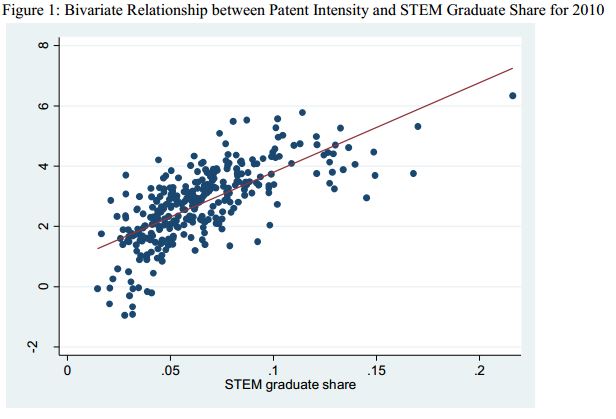In a new article, Economist John Winters (OSU) looked at the link between collegiate STEM training (university degree) and innovation-intensity (per capita patenting). The findings are not surprising — locations with more STEM graduates have a higher per capita rate of patenting. Of importance, Winters found this to be true regardless of whether the graduates were US-native or foreign trained.
Figure 1 above charts the per-capita patenting (log) against the population-share of STEM-graduates. Each point represents one of the 300+ U.S. metropolitan area in the study. The outlier at the right is Silicon Valley which has both the highest per-capita patenting rate and the highest population-share of STEM graduates. You’ll note that the per-capita patenting rate is on a log axis and that the SV patenting rate is much greater the chart suggests if thinking linearly. Winters does not report on the identity of the low-end regions.
Although the paper does not delve into this, the phenomenon here is almost certainly not one of straight causation. Silicon Valley and Boulder (No. 2 on the list) have both learned how to invest in research and investment likely leads to more local STEM graduates. In that sense, the solution of ‘getting more STEM graduates’ is unlikely to be a success on its own.
A second problem with the paper is that it talks about ‘innovation’ but simply uses a patent-count measure as a proxy for innovation. Although innovation is a legally necessary element of a patent, many important innovations are not patented. Further, although per-capita patenting provides a simple and easy to explain measure, it avoids the reality that some inventions are highly innovative and important while others are not.

I’ve noticed that this blog has taken a more statistical turn over the years. Personally I prefer the good old fashioned interesting analysis of patent doctrines and Federal Circuit opinions, as opposed to statistical studies merely confirming things that are not at all surprising or particularly interesting.
Thanks Joe. I will note that I’ve been doing this type of post for the past decade: See link to patentlyo.com
Ok, I’m just saying it seems like there are more of them now. And that’s not to say that you’ve stopped doing the stuff I like, it just seems like the primary focus has shifted a bit.
This graph looks logrhithmic to me; there doesn’t seem to be a simple relationship between patent intensity and STEM graduate share. If the data were plotted without the log transformation, it suggests that more STEMs in a geographical area produce a greater number of patents than would otherwise be anticipated. Synergy amongst engineers and scientists. I’d expect Boston and Seattle to be represented in some of the data points on the right. And, Silicon Valley is not to be viewed as an outlier, just a place of maximum synergy.
I forgot to add that the USPTO is locating a satellite office near Silicon Valley; link to uspto.gov
All this does is affirm the quite obvious that SV has been leading this nation and the world in technology development for some time.
The PTO should be located here; and the aphorism “What’s good for GM is good for the USA” should be remixed to “What’s good for SV is good for the USA.”
Thank goodness we’re finally invalidating all of their patents. Now we’ll finally find out who’s actually leading in innovation once we clear all of the silly software patents from the roles, right?
Comments are closed.